| |
|
|
| |
Colonial Spiked Helmets
Schutztruppe Pickelhauben
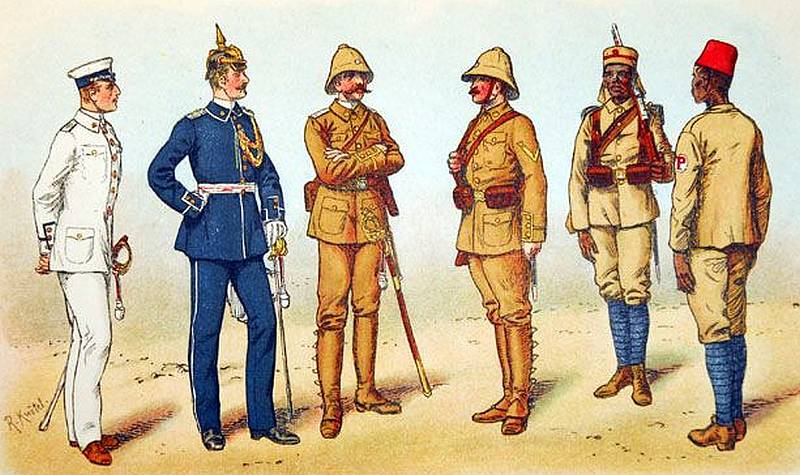
German East African Schutztruppe
Uniforms 1891-96
Note the officer with a Pickelhaube, second from left
Illustration by R Knötel from
German Schutztruppe in East Africa 1889-1911 by Ernst Nigmann
| |
|
|
|
The spiked helmet or 'Pickelhaube' is famously associated with soldiers
of the
German imperial era, yet is was very rarely worn by the colonial
Schutztruppe.
The Pickelhaube was authorised for the Schutztruppe of German East
Africa only for home
use from 1891-96 (and those of German Cameroon 1895-96) again for a
very limited number of officers at the Colonial Office in Berlin from 1916-18. This makes
Schutztruppe Pickelhauben extremely
rare and in some cases entirely unique.
The Schutztruppe came under direct
imperial command and so wore an Imperial Eagle or 'Reichsadler' on the front rather
than a state emblem as worn by the German armies. The Reichsadler
came in two main forms, either 'flying' with its wings outstretched
or 'heraldic' with downswept wings. The eagle and all metal fittings
on the helmet generally matched the button colour of the uniform.
Another point to note is that the Pickelhauben of the Schutztruppe had
no state cockade on the left side, only an imperial cockade on the
right.
That is not to say however that all Pickelhauben with
the Reichsadler and imperial insignia are from the Schutztruppe. The
vast majority are not. Several other units coming under direct
imperial command such as the East Asian
Occupation Brigade in China and the Gendarmerie of
Alsace-Lorraine also wore imperial insignia and the Reichsadler on
their Pickelhauben. Some officials
and fortress personnel serving with the Marine Infantry were also authorised to
wear the Pickelhaube with a Reichsadler
Famously all Imperial German uniform
regulations have an exception to every exception, so we shall
look at all the helmets authorised with a Reichsadler individually
and then compare then in an easy chart. |
|
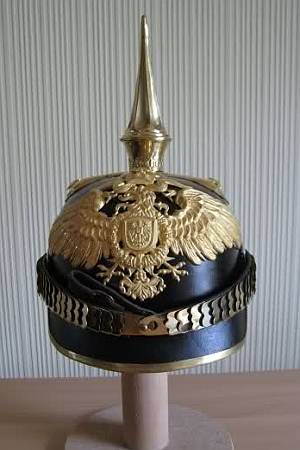
1916 Schutztruppe General's
Pickelhaube
Photo from
Traditionsverband |
| |
|
|
|
|
| |
|
|
| |
|
|
|
|
| |
1891
Schutztruppe Pickelhaube
The uniform regulations
of 4 June 1891 for the Schutztruppe of
East Africa authorised a Pickelhaube to be worn by offices and NCOs
when on home duty back in Germany. This regulation also applied to
the Cameroon Schutztruppe upon their formation in 1895.
The helmet
was based on those used by the Prussian Infantry at the time but
with several distinctions. The Schutztruppe Pickelhaube had a squared
peak and an imperial eagle with spread wings in yellow metal across
the front. The fittings, spike and chinscales were also in yellow metal.
Officers spikes were fluted and
had a cruciform base pinned with a star in each corner. NCOs spikes
were smooth with a base held by four plain buttons. An imperial
cockade was worn under the right side chinstrap boss. No cockade was
worn on the left side. The chinscales were also in yellow metal.
The Pickelhaube
worn by non combatant officials (doctors, medics, paymasters
and gunsmiths) was notable in that it had a heraldic eagle
(with downswept wings) and smooth spike even for officers.
On 3 May 1894 a new uniform regulation was passed
specifically for the one paymaster officer in East Africa.
His Pickelhaube fittings were of white metal, though the
stars on the base of the spike were of yellow metal.
The uniform
regulations of 19 November 1896 replaced the 1891
regulations and in them the Pickelhaube was replaced for
home duties with a Südwester hat
similar to that worn in South West Africa.
|
|
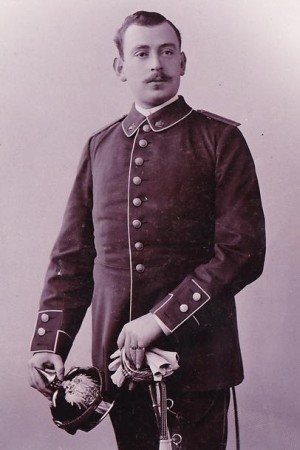
Sanitäts-Offizier
East
African Schutztruppe c1891-96
He wears the 1891 dark blue home
uniform with the Schutztruppe Pickelhaube bearing the
heraldic eagle and smooth spike of a medical officer.
Photo © Sergio Semino
of
Militaria-Online |
|
| |
|
|
|
|
| |
|
|
|
|
| |
1913
Schutztruppe General's Pickelhaube
In 1913 new regulations
authorised the Pickelhaube but only for General Officers. This was a
curious regulation as there weren't any serving Schutztruppe
Generals in 1913. It seems some helmets were at least made for
demonstration purposes.
The authorised
helmet was based on that of a Prussian infantry general and
had a squared peak, an imperial cockade under the right hand
chinstrap boss, yellow metal fittings, a heraldic imperial
eagle and a fluted spike with a cruciform base. On parade a
plume of white feathers, white red and black feathers
underneath replaced the helmet spike.
|
|

1913 Schutztruppe
General's Pickelhaube
Photo
© Martin Svoboda |
|
| |
|
|
|
|
| |
|
|
|
|
| |
1916
Schutztruppe Pickelhaube
On 25 February 1916
new regulations authorised a Pickelhaube again for home
service. By this stage in the war most the German colonies
had surrendered, while those Schutztruppe still fighting
were stranded in East Africa with no chance to implement new
uniform regulations. These regulations therefore only
applied to the officers and staff of the Colonial Office in
Berlin meaning that few very were ever made.
The helmet was
again based on that of the Prussian infantry but with a
flying imperial eagle, a single imperial cockade on the
right chinstrap boss and a squared peak. The eagle, spike
and fittings followed the button collar of the tunic.
Schutztruppe
Officers had white metal fittings on their Pickelhaube.
Their helmet spike was smooth and had a rounded base with
yellow metal stars attaching it. On parade a white hair
plume was worn in place of the spike.
General Staff
Officers also had white metal fittings but their helmet
spike was fluted and had a cruciform base. On parade a white
hair plume was worn in place of the spike.
General
Officers had yellow metal fittings and a fluted spike
with a cruciform base. On parade a plume of white feathers,
white red and black feathers underneath replaced the helmet
spike.
Officials
had metal fittings that matched the tunic button colour of
their branch. Senior officials had a small imperial eagle
super-imposed on their helmet eagle, while junior officials
had the imperial shield super-imposed.
|
|
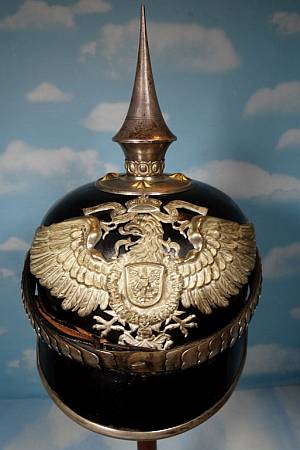
1916 Schutztruppe
Officer's Pickelhaube
Formerly of the
Siebentritt Collection, here photographed by
Der
Rittmeister |
|
| |
|
|
|
|
| |
|
|
| |
Other
Pickelhauben that bore the Reichsadler
The Schutztruppe were not the only imperial unit to wear the
Reichsadler and imperial insignia on the Pickelhaube. These
helmets sometimes appear in modern collections and sales
mistakenly labelled as Schutztruppe helmets.
|
|
| |
|
|
| |
|
|
|
|
| |
East Asian Occupation
Brigade
Pickelhaube
The East Asian Expeditionary Corps were sent to China in
1900 with the Pickelhauben of their home units. These were
made of black leather, with variations on the helmet plate
and cockades for the different German states and further
variations in the style of spike, peak, chinscales and the
type metal used for them with different ranks and arms of
service.
On 9 February 1901 new uniforms in
field grey were authorised for the East Asian Expeditionary Corps
(and its later successors, the East Asian Occupation Brigade and
East Asian Detachment). These uniforms included a new
universal Pickelhaube bearing a heraldic Reichsadler. The new helmet
varied most notably from the army and Schutztruppe
Pickelhauben by being made of field grey pressed felt rather
than black leather.
Recommended Internal
Link- East Asian
Pickelhaube
|
|
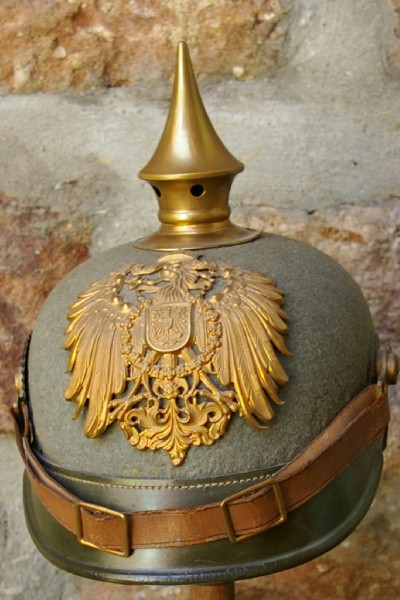
East Asian Grey
Felt Pickelhaube
Photo
© Francois Fischer |
|
| |
|
|
|
|
| |
|
|
|
|
| |
Alsace-Lorraine
Gendarmerie Pickelhaube
As the military police of an imperial
territory (rather than a part of Prussia or state of its
own), the Gendarmerie of the conquered provinces of Alsace
and Lorraine ('Elsass-Lothringen')
wore the Reichsadler on their Pickelhauben and had a single
imperial cockade under their right side chin strap boss. On
first glance these are sometimes mistaken for Schutztruppe
helmets in modern collections.
Several
varieties existed with plain and fluted spikes (local
officials wore helmets with fluted ball end spikes), but all
had a heraldic eagle with yellow metal fittings (whereas the
Schutztruppe usually had flying eagles and white metal
fittings). The helmet of the dismounted Gendarmerie was
based on that of the Prussian guards infantry with a round
spike base and a rounded peak. The helmet of the mounted
Gendarmes was based on that of the Prussian dragoons and had
a cruciform spike base and a squared peak.
|
|
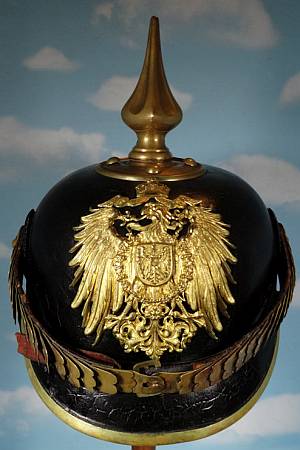
Alsace-Lorraine Gendarmerie
Pickelhaube
Photo ©
Der
Rittmeister |
|
| |
|
|
|
|
| |
|
|
| |
|
REICHSADLER PICKELHAUBE
DETAILS CHART
This
chart is intended as easy reference to help
recognise different types of spiked helmet or 'Pickelhaube'
bearing the imperial eagle or 'Reichsadler'
on the front. With the exception of the East Asian
grey felt helmets, these Pickelhauben were made of
black leather. They all had a single imperial
cockade under the right hand strap boss and bore the
Reichsadler on the front. In summary, unless the
Pickelhaube has a flying imperial eagle and a
squared peak is most likely not of Schutztruppe origin.
|
| |
Fittings |
Eagle |
Spike |
Base |
Peak |
Plume |
Schutztruppe Pickelhauben
1891-1918
Schutztruppe 1891-96 Regulations |
|
Officer |
yellow |
flying |
fluted |
cruciform |
squared |
none |
|
NCO |
yellow |
flying |
smooth |
|
squared |
none |
|
Doctor |
yellow |
heraldic |
smooth |
cruciform |
squared |
none |
|
Junior Official |
yellow |
heraldic |
smooth |
|
squared |
none |
|
Paymaster 1894 |
white |
heraldic |
smooth |
cruciform |
squared |
none |
Schutztruppe 1913 Regulations |
|
General Officer |
yellow |
heraldic |
fluted |
cruciform |
squared |
feathers |
Schutztruppe 1916 Regulations |
|
Officer |
white |
flying |
smooth |
rounded |
squared |
hair |
|
General Staff |
white |
flying |
|
|
squared |
hair |
|
General Officer |
yellow |
flying |
fluted |
cruciform |
squared |
feathers |
|
Official |
varied* |
flying |
|
|
squared |
none |
Other Pickelhauben with the
ReichsadlerEast Asian Occupation Brigade 1900 Grey Felt
Pickelhaube |
|
Infantry and
Cavalry |
yellow |
heraldic |
smooth |
rounded |
rounded |
none |
|
Artillery |
yellow |
heraldic |
ball |
rounded |
rounded |
none |
|
Pioneers |
white |
heraldic |
smooth |
rounded |
rounded |
none |
|
General
Staff |
white |
heraldic |
smooth |
rounded |
rounded |
|
|
Generals |
yellow |
heraldic |
smooth |
rounded |
rounded |
|
Alsace-Lorraine Gendarmerie |
|
Mounted |
yellow |
heraldic |
|
|
squared |
none |
|
Dismounted |
yellow |
heraldic |
|
rounded |
rounded |
none |
| |
|
|
|
|
|
|
Marine Infantry Officials and Fortress Personnel |
|
Officials |
varied* |
heraldic |
smooth |
|
rounded |
none |
|
Junior Officials |
|
|
|
|
|
|
|
Fortress
Personnel |
white |
heraldic |
smooth |
|
rounded |
none |
| |
|
|
|
|
|
|
| |
|
|
|
|
|
|
|
* Metal fittings on the
Pickelhaube usually matched the button colours of
the uniform. In the case of officials this varied
from branch to branch, usually based on the Prussian
army system. For example a medic or gunsmith would
have yellow metal and a paymaster or ... would have
white metal. |
| |
|
|
|
|
|
|
|
|
| |
Recommended External Links-
Traditionsverband Information on Schutztruppe Pickelhauben
Schutztruppe General's Helmet Article on Traditionsverband
Reichsadler Discussion on Pickelhaubes Forum
Photos of the Alsace-Lorraine Gendarmerie at Kukri
Recommended Further Reading-
The German Colonial Troops
1889-1918 by
Jürgen Kraus and Thomas Müller,
Verlag Militaria
Die deutschen Marinen 1818-1918: Organisation, Uniformierung,
Bewaffnung und Ausrüstung
by Rolf Noeske and Claus P. Stefanski, Verlag Militaria
Das Deutsche Heer,
Friedensuniformen bei Ausbruch des Weltkrieges written and
illustrated by H. Knötel and P. Pietsch
Thanks to Jim Turritnetti, Arne
Schöfert and Joe Robinson for help with this
article.
|
|
Please
contact me here if you have more
information or photos on this topic.
Back to
Main Menu for German Colonial Uniforms
|